Begonias are beautiful, versatile plants perfect for gardens, patios, and balcony growing spaces. If you’re looking to fill your garden with bright colours and different shapes of blooms, growing begonias is a fantastic option for your garden.
If you’re new to gardening, caring for Begonias can be intimidating. With so many varieties and care requirements, figuring out where to start can take time. But fear not, once you get the hang of it begonias are incredibly rewarding flowers!
This guide will provide tips on everything you need to grow begonias. From choosing the right soil to watering and fertilizing; we’ll cover all the basics to help you cultivate healthy and vibrant Begonias.

Want the inside scoop on more gardening tips? Get early access to all my blogs and exclusive content by signing up for my newsletter!
Introduction to the Beautiful and Diverse World of Begonias

With their stunning colours and unique shapes, Begonias have captivated garden enthusiasts for centuries.
From vibrant blooms to striking foliage, Begonias offer a wide range of options for every gardener’s taste.
These versatile plants belong to the Begoniaceae family, which originates from tropical and subtropical environments worldwide and comprises more than 1,800 different species and countless hybrids.
One of the most appealing aspects of Begonias is their diversity.

Begonias have succulent-like leaves and stems where they store ample amounts of water. And Begonias with tuberous roots store water there as well.
Begonias are available in various plant forms, including upright, trailing, shrubby, and tuberous. Regardless of your available space, there is a Begonia variety that will thrive and add beauty to your garden or indoor space.
Furthermore, Begonias are known for their intriguing foliage. Begonias with captivating foliage don’t often have brilliant floral displays. You could say that the flowers are secondary when the foliage is stunning.
A fun fact for plant nerds: Begonias are monoecious plants, which means that they bear flowers that are either male or female on the same plant. Some Begonias have separate male and female flowers grow in the same cluster.
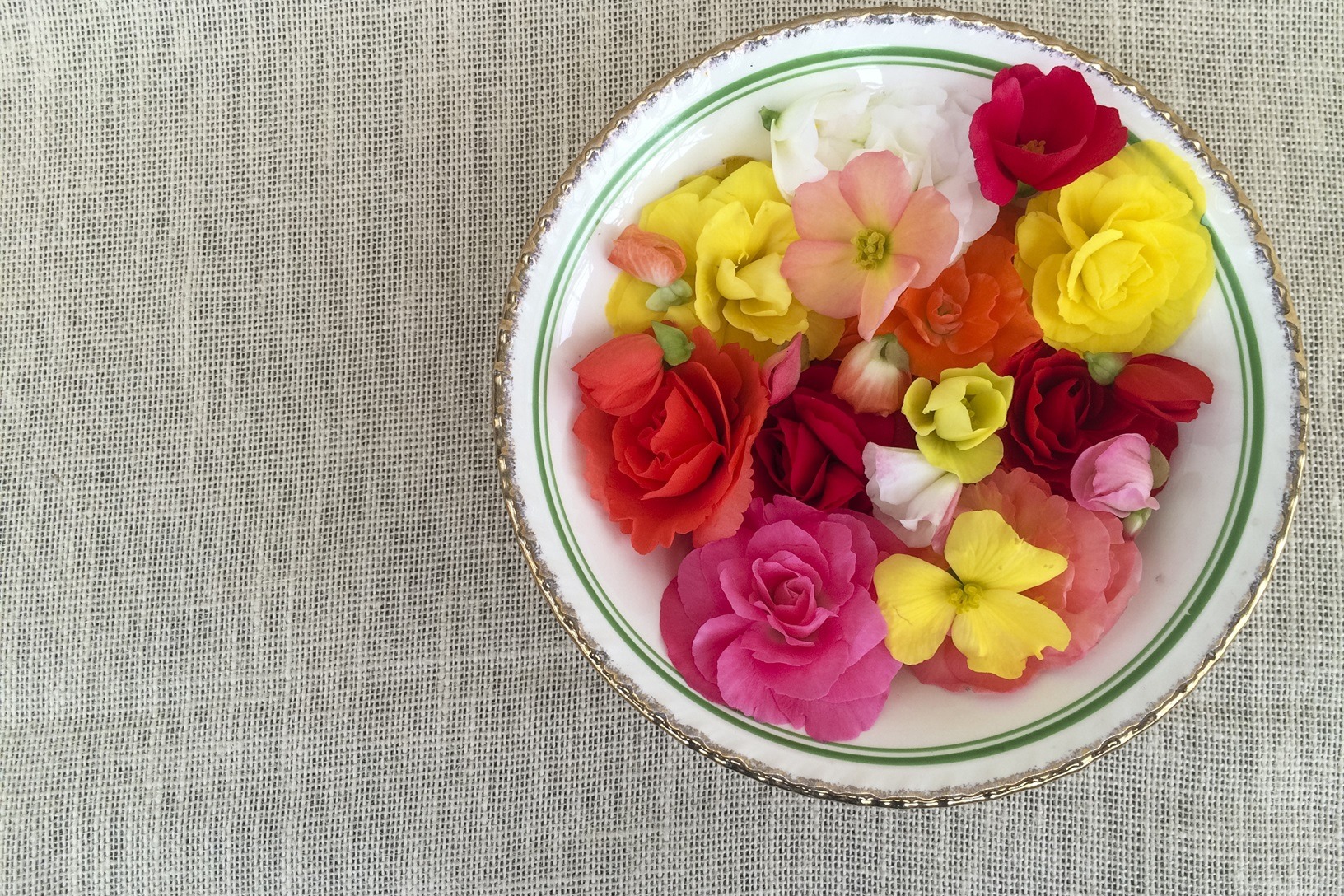
And lastly, Begonia flowers are edible with a sour, citrusy flavour. They can be used in salads as garnish or as a safe cake decoration.
Whether you prefer the eye-catching blooms or the captivating foliage, Begonias will surely add elegance and charm to any setting.
Types of Begonias: A Breakdown of the Different Species and Varieties of Begonias
Understanding the different types of Begonias will help you choose the right ones for your garden or indoor space and enable you to appreciate their unique characteristics and care requirements.
There are numerous ways to classify Begonias, and in this blog, I will use a combination of flower type and growth habit to categorize them.

Want the inside scoop on more gardening tips? Get early access to all my blogs and exclusive content by signing up for my newsletter!
1. Tuberous Begonias

Also known as ‘Bulb Begonias’, tuberous Begonias are popular among gardeners.
Tuberous Begonias can be grown from seed or tuberous roots, a fleshy, nutrient-storage structure from which they are named.
Many Tuberous Begonias grow upright and produce vibrant, bell-shaped blooms in various colours, including reds, pinks, oranges, and yellows.
These Begonias thrive in shady or partially shady areas and are often used in hanging baskets, containers, or as bedding plants.
Bossa Nova Begonias are a trailing tuberous Begonia that produces single flowers in a stunning colourful display of reds, oranges, pinks, and white.
2. Rex Begonias

Rex begonias are prized for their striking foliage, which comes in many patterns, colours, and textures, including intricate swirls, spots, veins, or metallic sheens.
These Begonias prefer indirect light and high humidity, making them well-suited for indoor cultivation or shaded outdoor areas.
3. Fibrous Begonias (Wax Begonias, Semperflorens Begonia)
Fibrous Begonias, or Wax Begonias, are some of the most common and versatile Begonias available.
Fibrous Begonias are valued for their compact, uniform growth pattern, profusion of small flowers, and ability to thrive in both sun and shade. They grow well from seed and tolerate a lot of sun in high-humidity areas.
These Begonias come in various colours, including white, pink, red, and bi-colours, making them an excellent choice for borders, beds, or containers.
Speaking of diversity, Fibrous Begonias bear varieties with leaf colours in shades of green, and others have dark brown-reddish leaves.
4. Cane Begonias (Angel Wing Begonias)
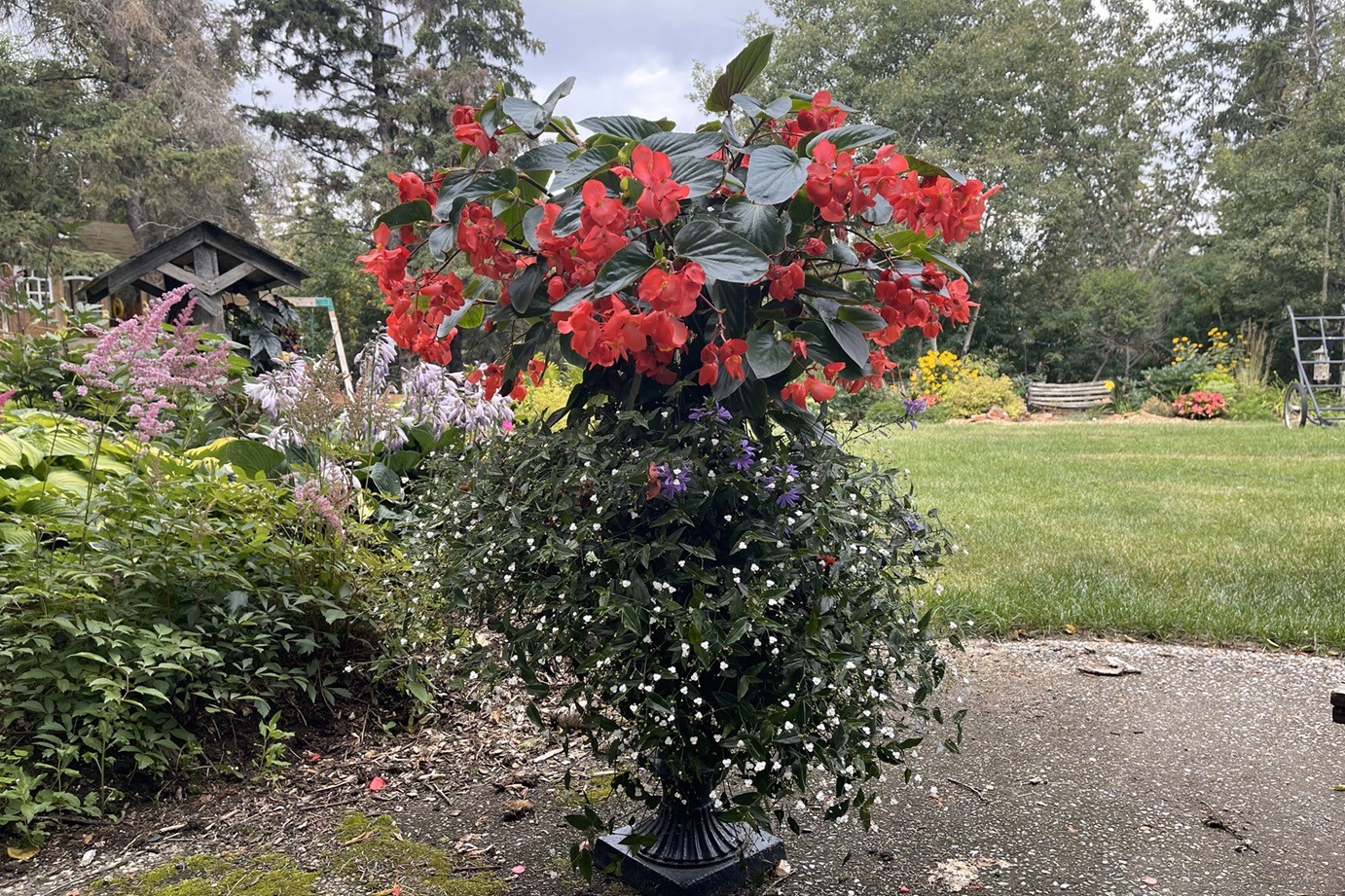
Cane Begonias, also known as Angel Wing Begonias, are characterized by their long, arching stems and attractive asymmetrical leaves.
They have strong, upright stems that support their long, ovate leaves and produce clusters of delicate flowers in red, pink, or white shades.
Cane Begonias can tolerate a few hours of mild sunshine daily.
These Begonias can reach impressive heights and are often grown as houseplants or in sheltered outdoor areas.
Dragon Wing, Bossa Nova, and Canary Wing Begonias (some of my personal favourites) are included in this category.
5. Sun Tolerant Begonias

Commonly known in North America as Solenia Begonias, these prolific flowering Begonias are bred out of a group called Hiemalis Begonias, a cross between tuberous and wax Begonias.
Botanically, they have semi-tuberous roots and grow in full shade to full sun exposure.
I say *full sun* with an asterisk because they can burn in full, hot, sunny locations.
These Begonias are also more wind and mildew-resistant than any other Begonia type.
Ideas for Displaying Begonias in Your Garden

Begonias are known for their stunning colours and textures, making them a popular choice for outdoor displays.
When you choose your spot to showcase your Begonias, always know the number of hours of sun and the wind patterns so you can determine if that location is optimal for growing them.
Here are some ideas for displaying Begonias in your garden:
1. Begonia Hanging Baskets
Hang Begonia-filled baskets from porches, balconies, or pergolas to create a cascading effect.
Mix Begonia varieties with complementary foliage colours and textures to create an eye-catching display.
2. Begonia Window Boxes
Transform your windows into a colourful spectacle by planting Begonias in window boxes.
Choose Begonia varieties that thrive in partial shade and complement the colour of your garden theme, house, or window frame.
3. Begonia Mixed Planters
Combine Begonias with other plants, such as ferns, ivy, or trailing vines, to extend your arrangement vertically in mixed planters.
The contrasting foliage textures and colours will create a visually striking arrangement.
4. Begonia Edging or Border Plants
Use Begonias as edging or border plants for in-ground gardens and raised garden beds.
The low-growing varieties will add a pop of colour and texture to your garden while creating a defined border.

Want the inside scoop on more gardening tips? Get early access to all my blogs and exclusive content by signing up for my newsletter!
Tips for Selecting the Perfect Begonia for Your Gardening Space

Choosing the right Begonia for your garden helps to ensure successful growth and vibrant blooms.
With so many Begonia varieties available, it can be overwhelming to make a selection.
However, by considering your preferences and the specific growing conditions, you can find the ideal Begonia to suit your needs.
1. Determine Where You Want to Grow Your Begonias

Begonias can be grown in full, partial, and complete shade locations.
Tuberous Begonias are known for their stunning flowers in shady areas.
On the other hand, if you have a sunny outdoor space, Fibrous (Wax) Begonias or Solenia Begonias will be a better choice as they can tolerate more direct sunlight.
2. Get to Know Your Growing Environment
Consider the growing conditions in your area, determine the number of hours of direct sunshine your area receives, and note how windy the space is.
The specific growing conditions for various Begonias are detailed above.
Most Begonias hate wind and shred in mild breezes because of their succulent leaf structures. Solena Begonias are the most wind-tolerant of all but still be careful.
3. Consider the Size and Growth Habits of the Begonia
Mature size and growth habits are other considerations when choosing a Begonia.
Some Begonias, like Tuberous, Solenia, and Dragon Wings, grow upright, making them perfect for adding height and drama to your garden or container.
Others, like Bossa Nova or Canary Wing Begonias, have a trailing or cascading growth pattern, ideal for hanging baskets or trailing over the edges of containers.
If you have limited space, compact or dwarf varieties are available that will fit well in smaller gardens or even on window ledges.
4. What Kind of Begonia Flowers do You Like?

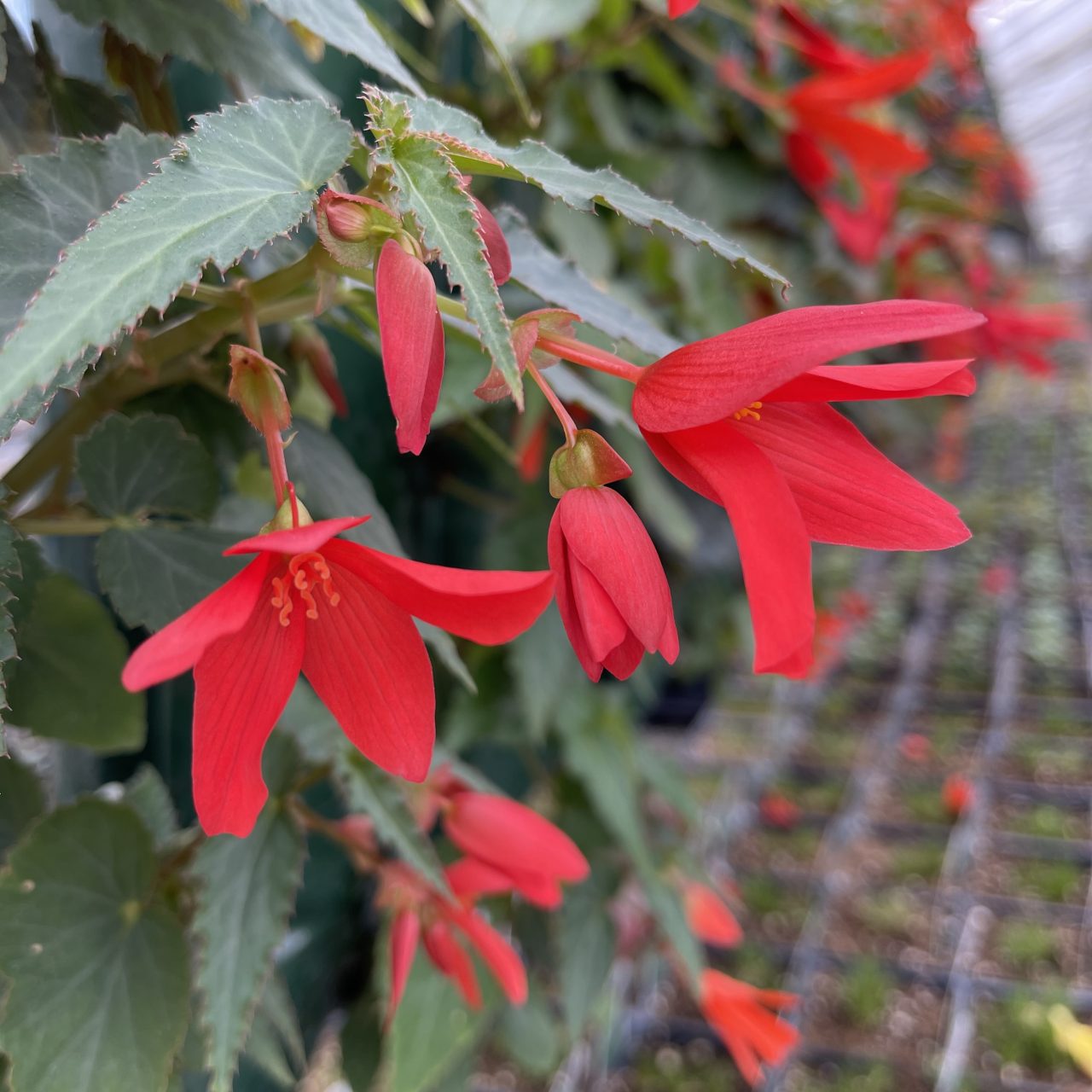
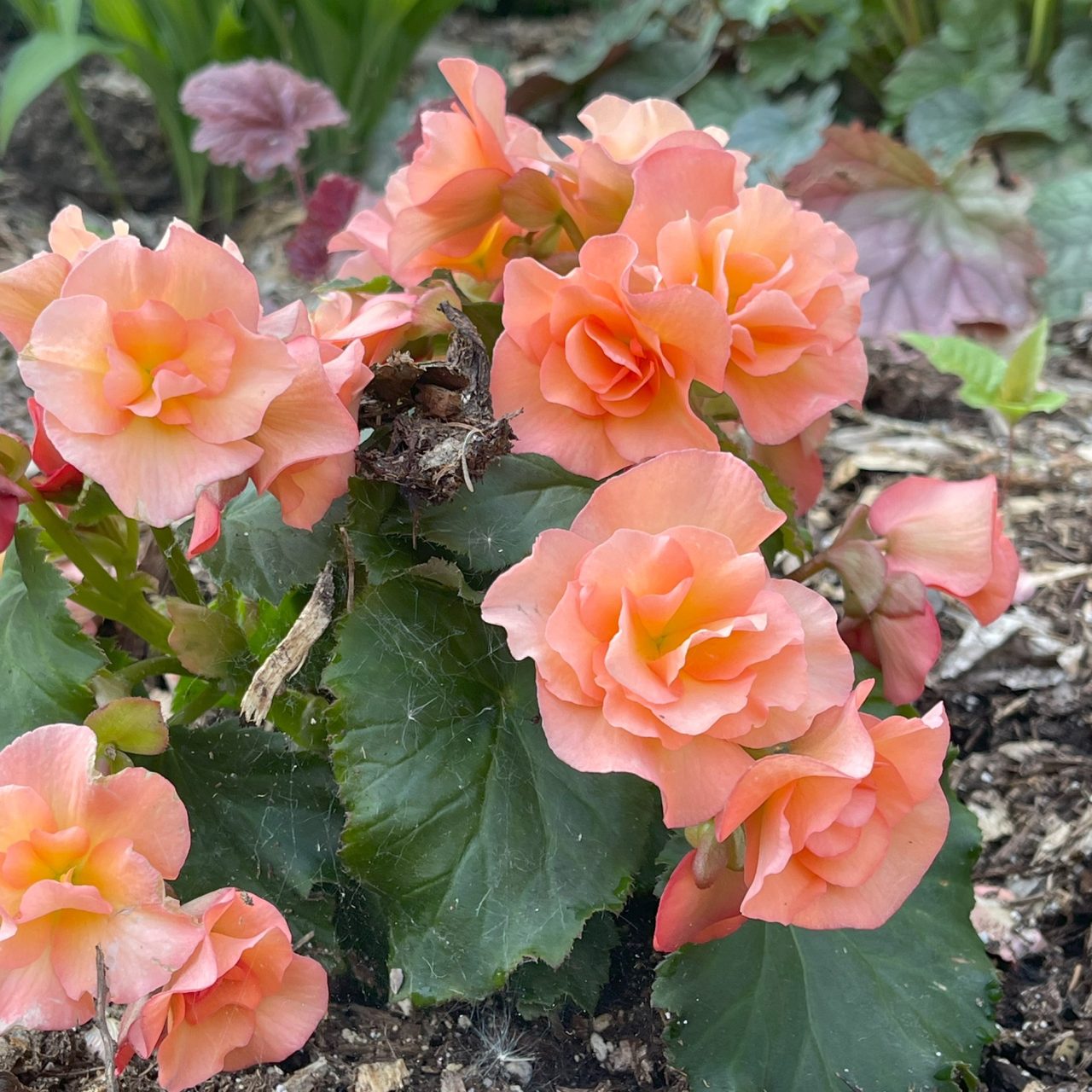
Another factor to consider is the type of Begonia flowers you prefer.
Begonias come in a wide range of colours, including shades of red, pink, orange, white, and yellow.
Some Begonias are heavily ruffled, while others have smooth edges.
Some Begonia varieties have variegated or patterned foliage, adding an extra visual appeal.
Take time to explore the different Begonia varieties and choose the ones that best complement your personal taste and desired aesthetic.
Tips for Growing Begonias Outdoors

Growing Begonias outdoors can be a rewarding and beautiful addition to any garden or container.
Here are some tips to help you cultivate amazing Begonias and keep them thriving throughout the growing season.
1. When to Plant Begonias Outdoors
When it comes to planting Begonias outdoors, timing is key.
Begonias come from the tropics and are very sensitive to cold temperatures.
Wait until all risk of frost has passed and the soil has warmed up before planting your Begonias, which is typically in late spring or early summer. I place Begonias outdoors in my zone 3-4 garden in the first or second week of June.
Choose a location that receives the required amount of sunlight exposure, as some Begonias like full to partial shade, and others like full sun.
2. The Best Soil for Begonias
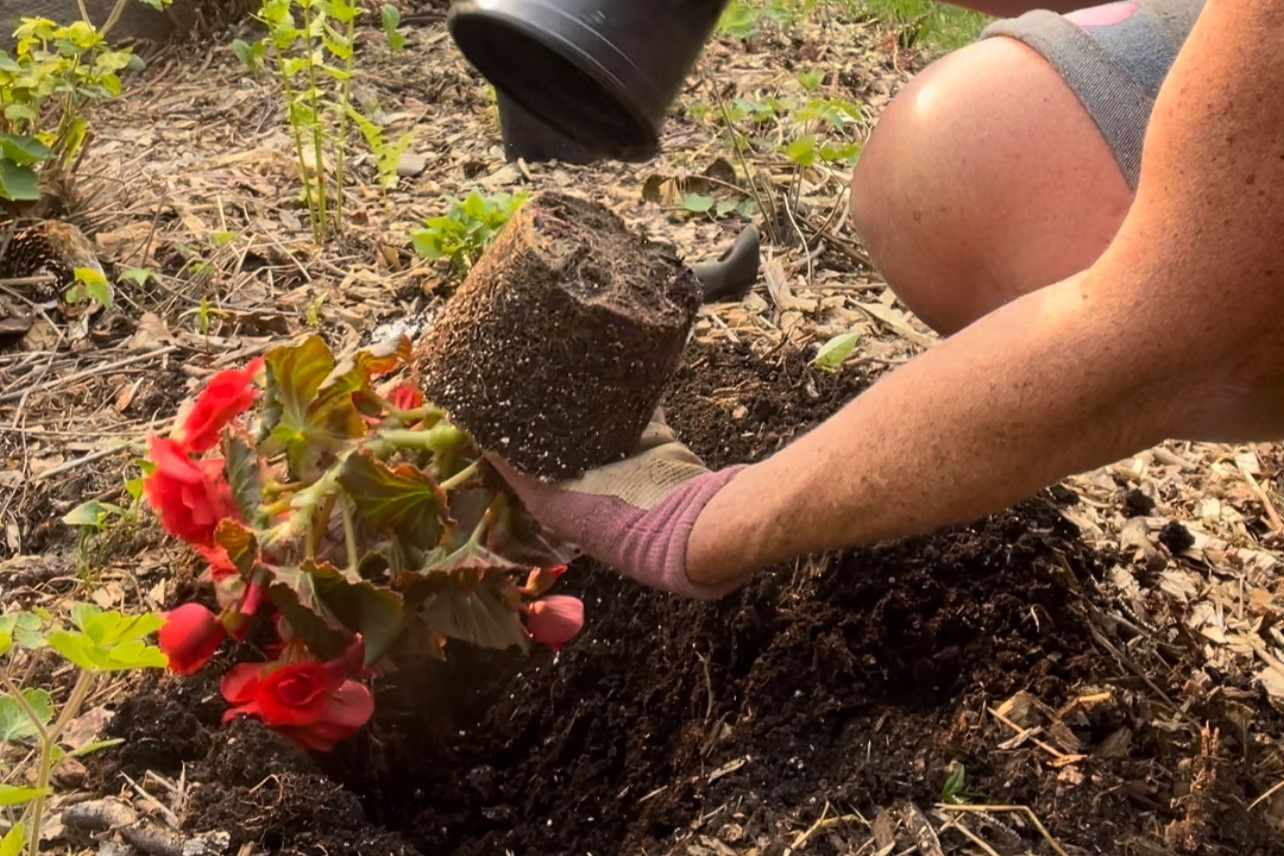
Soil quality is crucial for successful Begonia growth.
Begonias must have well-draining soil because they are very susceptible to root rot.
Adding organic matter, like compost, is one of the best ways to improve the soil’s quality and drainage.
Take time to remove any weeds or debris from the planting area to reduce nutrient competition and provide ample space for the Begonias to grow.
3. How to Plant Begonias

Whether you are planting a Begonia in the ground, in a planter, container, or hanging basket, dig a hole that is slightly larger than the root ball of your Begonia plant.
Place the Begonia in the hole, ensuring the top of the root ball is level with the soil surface. Double-check that the root ball isn’t buried deeply to avoid root rot.
Gently backfill the hole with soil and avoid compacting the soil, as that will affect soil drainage capability.
Water the newly planted Begonia thoroughly to reduce any stress from the transplanting process.
If the soil sinks, top it up with a little more soil until it is level with the top of the root ball.
4. Watering Begonias

The most common problem Begonias encounter is being overwatered and developing root rot.
Begonias are fleshy plants that trick us into thinking that they need a lot of water, but they don’t. Their succulent-like leaves and stems store a lot of water, and Begonias can go fairly long periods without added hydration.
I only water my shade Begonias every 7-10 days in a typical growing season; the sun Begonias get water more frequently, depending on the soil moisture.
Always assess soil hydration before watering Begonias to avoid waterlogging their roots.
You can check soil hydration by sticking the entire length of your index finger in the soil. When the soil is dry at the tip or first knuckle, it’s time to water.
When you water Begonias, water them thoroughly at the base of the plant, avoid wetting the foliage, and let the water drain from the roots naturally.
Mulching around the base of the plants can help retain moisture and prevent weed growth.
Related: What is Mulch? Making Garden Magic with Mulch
5. Fertilizing Begonias
Fertilizing regularly optimizes Begonia’s growth and blooming potential.
I recommend fertilizing Begonias every 7-10 days during the growing season. If the Begonias don’t require water in 7 days, then fertilize them as it coincides with their watering needs.
My favourite fertilizer is ‘Nature’s Source’, but formulations like 20-20-20 or 15-30-15 work well, too.
Follow the instructions on the fertilizer packaging for the correct dilution rate and frequency of application.
Deadheading and Pruning Begonias

Deadheading and pruning Begonias are also important care aspects to promote healthier and bushier growth.
Pruning Begonias by removing dead, diseased, or excess foliage keeps them looking great, helps increase air circulation throughout the plant, and reduces the potential for fungal and bacterial disease development.
Keep your Begonias tidy by removing any spent blossoms (deadheading) and removing old, yellowed, brown, dead, or diseased leaves.
If Begonia stems are growing long and straggly, pinch them back a few growing nodes. A node is where leaves emerge from the stem. This will stimulate the stem to branch out with stocky, robust growth.
Conclusion
Begonias are stunning plants that can add dramatic splashes of colour and beauty to any low-light or shade garden.
As an added bonus, many Begonia varieties can be transferred and grown indoors during the winter.
Whether you’re an expert gardener or just getting started, begonias can be tricky. But, armed with this information, it’s my dream that you can confidently embark on your Begonia-growing journey and create a lush and vibrant display that will impress everyone who sees it. If you have any other questions about growing begonias or making the most of this year’s gardening season, please reach out! You can also follow along for new tips and information with my newsletter.
Photos taken at Thiels Greenhouses in Bruderheim, Alberta and Christie’s Greenhouse in High Prairie, Alberta. Many thanks to Nadine and Christie!
©Sharon Wallish Murphy ©Gardening with Sharon































